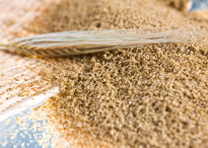
Choline chloride 70% Corn Cob
Choline chloride 70% Corn Cob is tawny granule with slightly peculiar stink and hygroscopic. corn cob powder, silica are for feed use excipients added to aqueous choline chloride to make choline chloride powder.
| Executive Standard | Specifications |
| Q/3700BNB001-2010 | 70% |
Description
Choline (2-hydroxyethyl-trimethyl ammonium hydroxide), usually classified as complex vitamin B (often called vitamin B4), maintain the physiological functions of animals’ bodies as a low-molecular organic compound that can be synthesized in vivo, but usually required in feed as a single vitamin, the largest demand in feed additive. It can regulate fat metabolism and transformation in vivo, whereby preventing abnormal fat accumulation in liver and kidney and tissue-degenerating, promote re-formation of amino acids and aid the utilization of amino acids, sparing methionine partly.
Choline chloride, the most common and economical form of choline, is mainly for mixing additives to animal feed. Note that choline chloride must be added to feed as the last step because of its damaging effects on other vitamins, particularly with the help of metallic elements, it makes vitamin A, D, K rapid destruction, hereby make sure no choline added to multi-dimensional formulation and compound feed mixed with choline should run out as soon as possible
The shortage of choline in animals’ feed may arouse corresponding symptom, such as,
-To poultry slower growth, reduced egg production, specifications shrink. Poor hatch of eggs, fat accumulating in liver and kidney and fat degenerating in liver, catching perosis, behavioral disorders, and muscular dystrophy.
-To pigs slower growth, behavioral disorders, mental disorders, muscular dystrophy, poor fertility, excess fat stored in liver.
-To bovine respiratory disturbance, behavioral disorders, loss of appetite, slower growth
-To fishes slower growth, acquiring fatty liver, bad feeding efficiency, kidney and intestinal bleeding. Other animals (cats, dogs, and other fur-bearing animals) behavioral disorders, fatty liver, coat color getting inferior.




